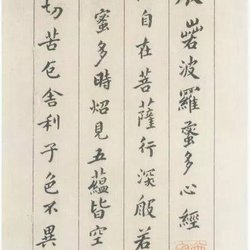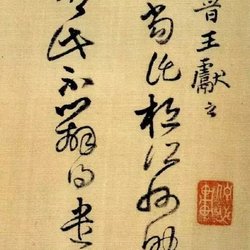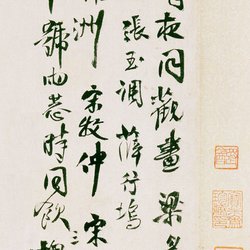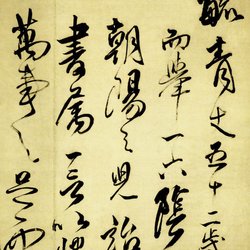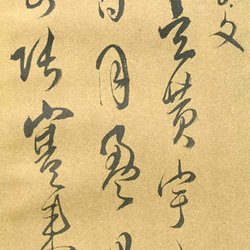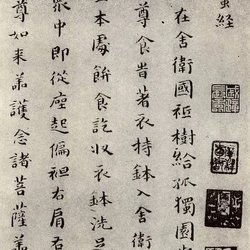Master Fu Shan and Fu Qing are probably the most famous figures in Shanxi since the Ming and Qing Dynasties. With a small life and a commoner's clothing, he was endowed with many images by later generations. In Jin Yong's novels, Fu Qingzhu hides his secrets and has unparalleled martial arts skills; in film and television dramas, Fu Zhenshan hangs a pot to save the world, with a heart of green blood; in the wonderful painting, the Taoist in Zhu Yi rides a crane and a luan, and he is transcendent.
Fu Shan in calligraphy is somewhere between a knight, a doctor, and an alchemist.

"The Story of Mr. Fu Qingzhu of Yangqu" says (Fu Shan): "From the small and large seal scripts to the official script, they are all exquisite, and they are also skilled in painting." He likes to write with seal script and emphasizes bone strength to form his own unique look.

Fu Shan's scroll of "Reading the Seven-Character Poems of Chuan Deng in Cursive Cursive", silk edition, 178.6×48.7cm, collected by Tianjin Museum
This is a seven-character poem read in cursive script, signed "True Mountain". There is a style stamp on one side, and two corner stamps on the lower left and right corners. The calligraphy of this scroll is a combination of cursive and cursive. The calligraphy is mainly upright. Although there are not many odd postures, it can be opened and closed freely. It is completed in one go: the thick and light dry and wet ink, the thick and thin rolling of stipple, the exquisite openness of the brushwork, and the perfect combination. "To the vast and to the subtle" is the purport of the mean. It can be seen that Fu Shan’s traditional culture and calligraphy skills are profound.

Fu Shan's "Five Rhymed Poems on Wind and Snow Blowing in Cursive Script" on scroll, damask, 185.7×51cm. Collection of the Palace Museum, Beijing
This scroll contains a five-character poem by Du Fu, a famous poet in the Tang Dynasty. It is later identified as "written by Mr. Songchu, Ci Bo Jiao Zheng", inscribed with "Fu Zhenshan" and sealed with "Fu Shan Seal". This scroll has no Tibetan seal, and the specific writing time is unknown. Judging from the calligraphy style, it must be a work by Fu Shan in the middle and late period.
According to the "Inscriptions and Postscripts of Fangjian Pavilion" written by Guo Shangxian of the Qing Dynasty: "Mr. Zhizhi was a first-class figure in the early days of the country. The world fought for his division of responsibilities, but his calligraphy was full of vitality, which is even more special." The calligraphy of this scroll is majestic. The continuous flying, ups and downs, and the natural connection between the characters show a vigorous and grand momentum, reflecting the strong personality of the calligrapher. The wording is not stable, and a single word appears unstable. However, when viewed across the board, the charm is vivid and the structure is natural. The changes in the size of the fonts increase the vividness and vitality of the work, giving people a sense of simplicity and beauty. feel.

Fu Shan's "Poem Scroll in Cursive Script" 187.8×51.4cm, collected by Suzhou Museum
Fu Shan, who was at the time when Dong Zhao's calligraphy style enveloped the calligraphy world, also learned from Zhao Mengfu, but later he criticized Zhao Mengfu very harshly. "I am not very fond of Zhao Zi'ang, but I despise him as a person, so I hate his books. If I take a closer look at it, I can't blame him for it. He is charming and graceful, which is a mean attitude. The smooth and round shape is still in the right vein. It is from "Lanting" Slightly changed, it is also determined by luck, not just the article." ("Frost Red Niche Collection"), this period is a typical conclusion in the history of calligraphy criticism that "the calligraphy is like the person". Naturally, this coincides with the changing times of his life. Relevant to the special period, he also said: "The writing of characters comes first from the people, and people have unique characters since ancient times. The outline often rebels against Zhou and Kong, and the pen and ink cannot make up for it." ("Writing Characters to Show Children and Grandsons"), this discussion is in response to the prevalence of "slave writing" at that time. The calligraphy world in the early Qing Dynasty was undoubtedly a sobering agent. He advocated uprightness and humility, devalued cleverness and beauty, and respected nature. His artistic proposition of being a man and being original was an authentic calligraphy, which can be imitated by future generations. At the same time, it is precisely because of his "knowledge and integrity" that people value him. I cherished his calligraphy even more.

